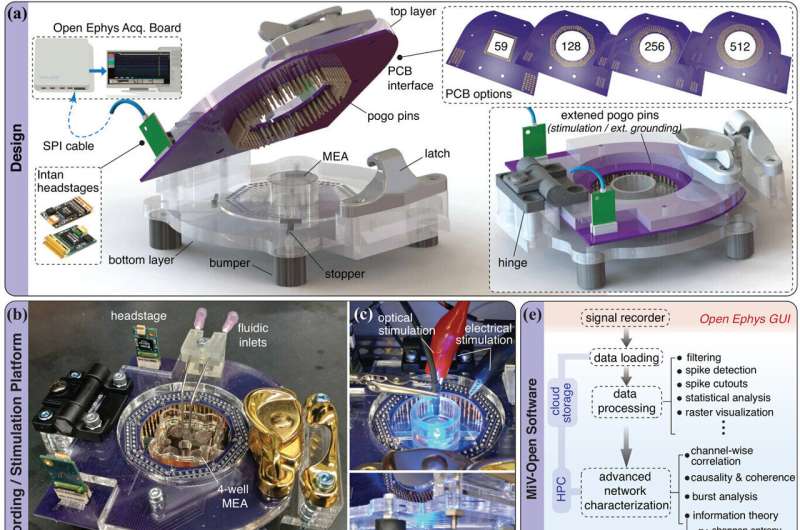This article has been reviewed according to Science X's editorial process and policies. Editors have highlighted the following attributes while ensuring the content's credibility:
fact-checked
peer-reviewed publication
trusted source
proofread
Researchers design new open-source technology for interfacing with living neurons

Neurons intricately communicate and respond to stimuli within a vast network, orchestrating essential functions from basic bodily processes to complex thoughts. Traditional neuroscience methods, relying on in vivo electrophysiology (within a living organism), often have difficulty addressing the complexity of the brain as a whole.
An alternative approach involves extracting cells from the organism and conducting studies on a culture dish instead (in vitro), providing researchers with enhanced control and precision in measuring neural processes.
In a new study featured in Advanced Science, researchers unveil a cost-effective, open-source in vitro system for interfacing with neurons, offering a more accessible avenue for researchers interested in neural interactions.
The study is part of a larger project called Mind in Vitro, which explores how neurons interact with each other, not only to better understand the functions underlying complex systems like the brain, but also for the goal of eventually using in vitro neural networks for computation. To accomplish such a goal, the MiV project encompasses a highly interdisciplinary group of researchers, including those from computer science, engineering, neurobiology, physiology, and more.
"The goal of the MiV project is to ultimately use neurons for computation," explained Zhi (Andrew) Dou, a graduate student in the Gazzola lab who helped lead the project. "This would allow for a system that is dynamic and constantly evolving, unlike traditional computing systems, and is actually more energy efficient as well."
The new MiV study, led by Mattia Gazzola (M-CELS), an associate professor of mechanical science and engineering, Xiaotian Zhang, a postdoctoral researcher in Gazzola's lab, and Dou, describes an innovative approach to measuring neuron activity using micro-electrode array (MEA) technology. While there are commercial systems that utilize similar technology, they are often expensive and marketed toward specific experimental approaches.
"The problem with the current technology for interfacing with neurons is that it's mainly commercial systems, which are more standardized for specific testing conditions, generally within biochemistry or traditional neuroscience," said Zhang. "Since we're interested in engineering computing paradigms out of living cells, our motivation for this was to move away from the more standardized commercial systems and build something ourselves that we would have full control over."
In the new MiV apparatus, cells are placed onto a plate that contains MEAs, allowing the technology to interface with the neural substrates. The electrodes detect voltage from the neurons, and that voltage is amplified and sent to a computer, which then processes the data.
Compared to the standard 60-electrode commercial system, the MiV system boasts over 500 electrodes, which allows for more data to be collected at once. The system also incorporates improved and/or novel features compared to commercial systems, such as portability, bi-directional communication with neurons, the ability to image neurons during recordings, and the ability to test multiple types of input (electric and optical) and multiple cell populations at a time.
Despite these enhancements, the cost to build the MiV system is shockingly 10-times cheaper than the cost of a commercial system, and completely customizable. In order to further the dissemination of the system, the researchers have made their hardware and software models for the MiV system open source and freely available online.
"Having our software and hardware be open source was really important to us," said Zhang. "We wanted to bring the cost down to make this technology available to others, and have it be more flexible and versatile so that researchers can really customize their experimental settings for whatever they need. Our system is not for only one lab, or one group of people interested in one specific thing, it's for everyone."
"We designed our system to be very easy to make and comprised of inexpensive parts, which will allow a lot of labs that can't afford the commercial system to have their own system," said Dou. "Even though the original design is for computational studies, we've made the structure easy to redesign and expand upon, so we're pretty sure this will satisfy researchers no matter the kind of studies they want to do."
The researchers say other labs are already showing interest in the new technology for their own experiments. The MiV team plans to keep improving the design to make the hardware more automated and accessible, as well as explore ways to quantify and expand the technology's performance.
Links for the open-source hardware designs and software can be found at https://gazzolalab.github.io/MiV-OH/ and https://miv-os.readthedocs.io/ respectively.
More information: Xiaotian Zhang et al, Mind In Vitro Platforms: Versatile, Scalable, Robust, and Open Solutions to Interfacing with Living Neurons, Advanced Science (2024). DOI: 10.1002/advs.202306826




















